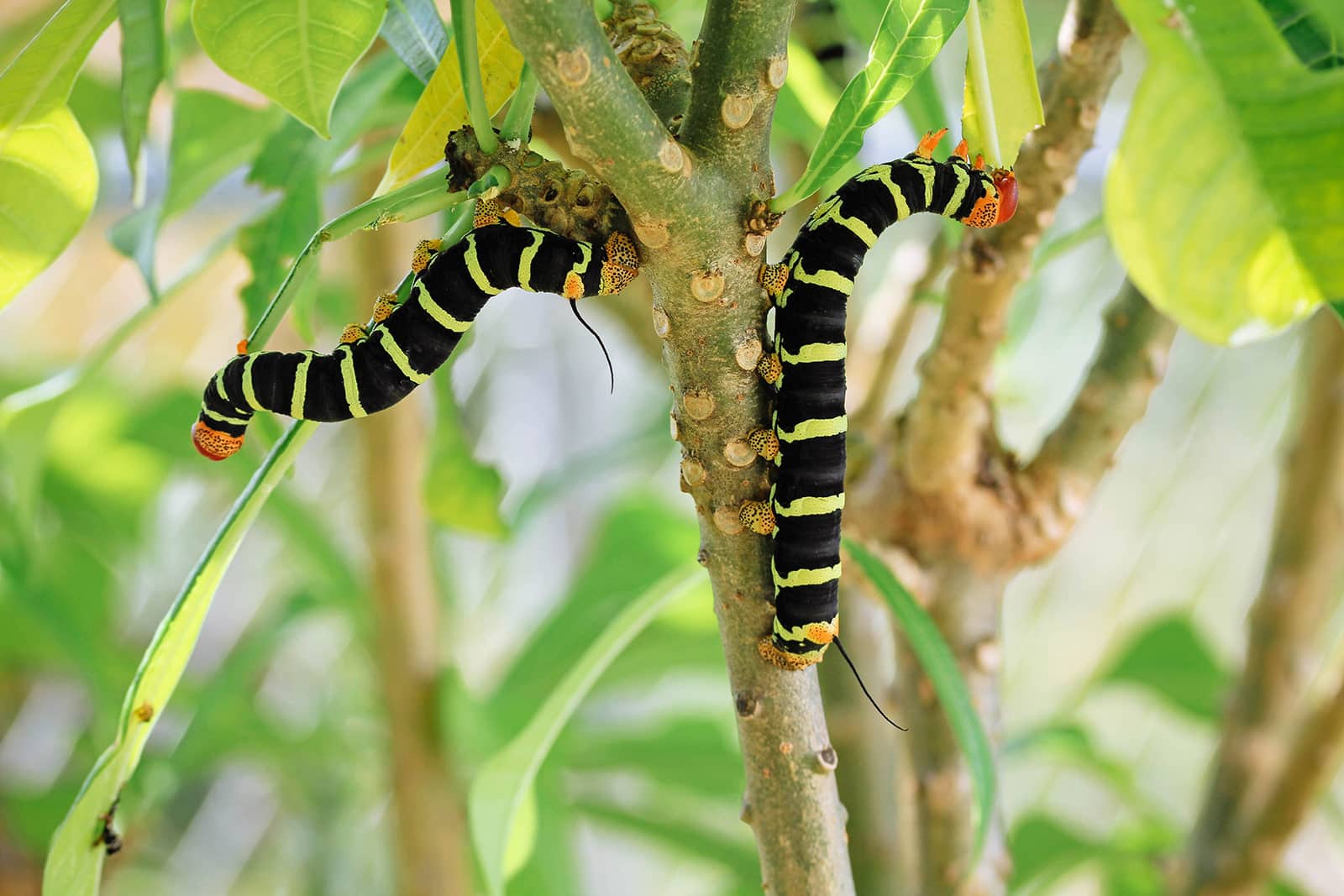If you tend to a garden, chances are you’ve encountered your fair share of caterpillars on every type of edible and ornamental plant. They typically leave a trail of chewed-up leaves or skeletonized plants in their wake, and while this is bad news for vegetable gardeners, caterpillars aren’t always destructive (at least, not on a noticeable level).
Striped caterpillars, in particular, are easy to spot in the early stages before they do too much damage, since their bold colors and striking patterns stand out easily against a backdrop of green foliage.
To find out what’s eating your plants, this simple A to Z visual guide will help you identify 17 of the most common striped caterpillars in your yard.
Disclosure: If you shop from my article or make a purchase through one of my links, I may receive commissions on some of the products I recommend.
How to identify striped caterpillars
While many striped caterpillars seem to look alike at first glance, they all have unique attributes that make them easy to identify, such as spines, horns, and other protrusions.
The tricky part is finding a caterpillar in a life stage (instar) where its appearance may not match the pictures below. All caterpillars go through multiple molts and instars before pupation, and their coloring may change each time.
Related: How to identify common green caterpillars in your garden
Sometimes a striped caterpillar starts out green before it develops its telltale stripes, and sometimes it turns brown or gray before it pupates. So besides appearance, consider the type of host plant it’s feeding on in order to properly ID the caterpillar.
Recommended products for caterpillar control:
- Bonide Caterpillar Thuricide Spray
- Monterey Bacillus Thuringiensis (B.t.) for Organic Gardening
- Safer Brand Bacillus Thuringiensis (B.t.) Concentrate for Caterpillars
- Bonide Captain Jack’s Dead Bug Brew Garden Dust
Common types of striped caterpillars
American painted lady caterpillar
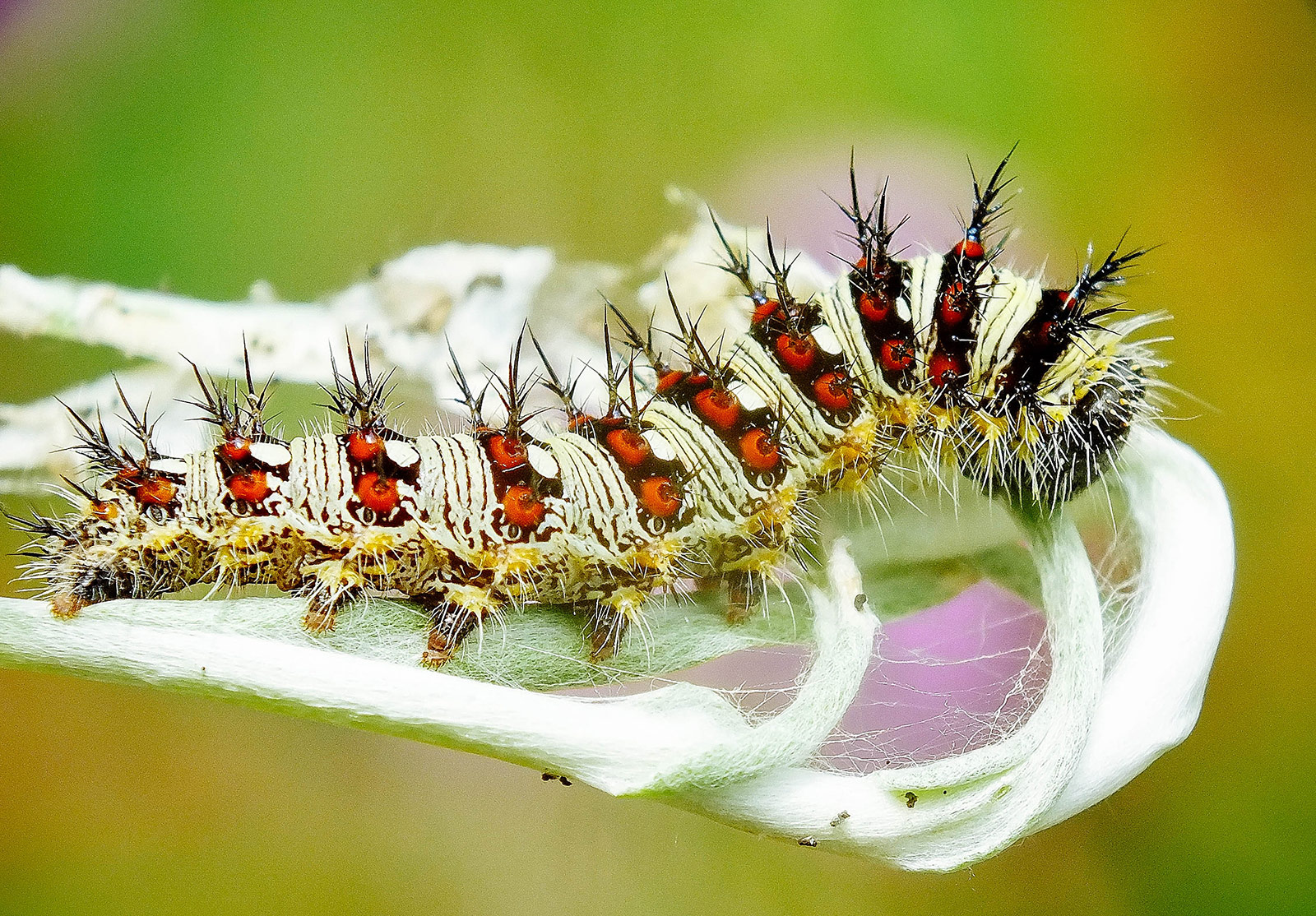
- Scientific name: Vanessa virginiensis
- Turns into: American painted lady butterfly (also known as American lady, painted beauty, or Hunter’s butterfly)
- Found in: Southern Canada throughout the US and southward to northern South America; occasionally seen in Europe, Hawaii, and the larger Caribbean islands
While American painted lady butterflies are beautiful in their own right, they’re best known for the characteristic nests their caterpillars make at the tops of host plants. The caterpillars silk together leaves and chaff at the tips of flower stalks where they hide during the day, and emerge at night to feed.
Full-grown caterpillars are 1.4 inches (3.5 centimeters) long with yellow bodies and thin black stripes. On some caterpillars, the black stripes are so wide that they appear to be black with narrow yellow stripes. They also have a row of large, branched, black spines with orange or red bases on each segment. White dots are found on either side of the body on segments two through eight.
Host plants include “everlasting” or “cudweed” herbs and their close relatives in the aster family (Asteraceae).
Angle shades moth caterpillar
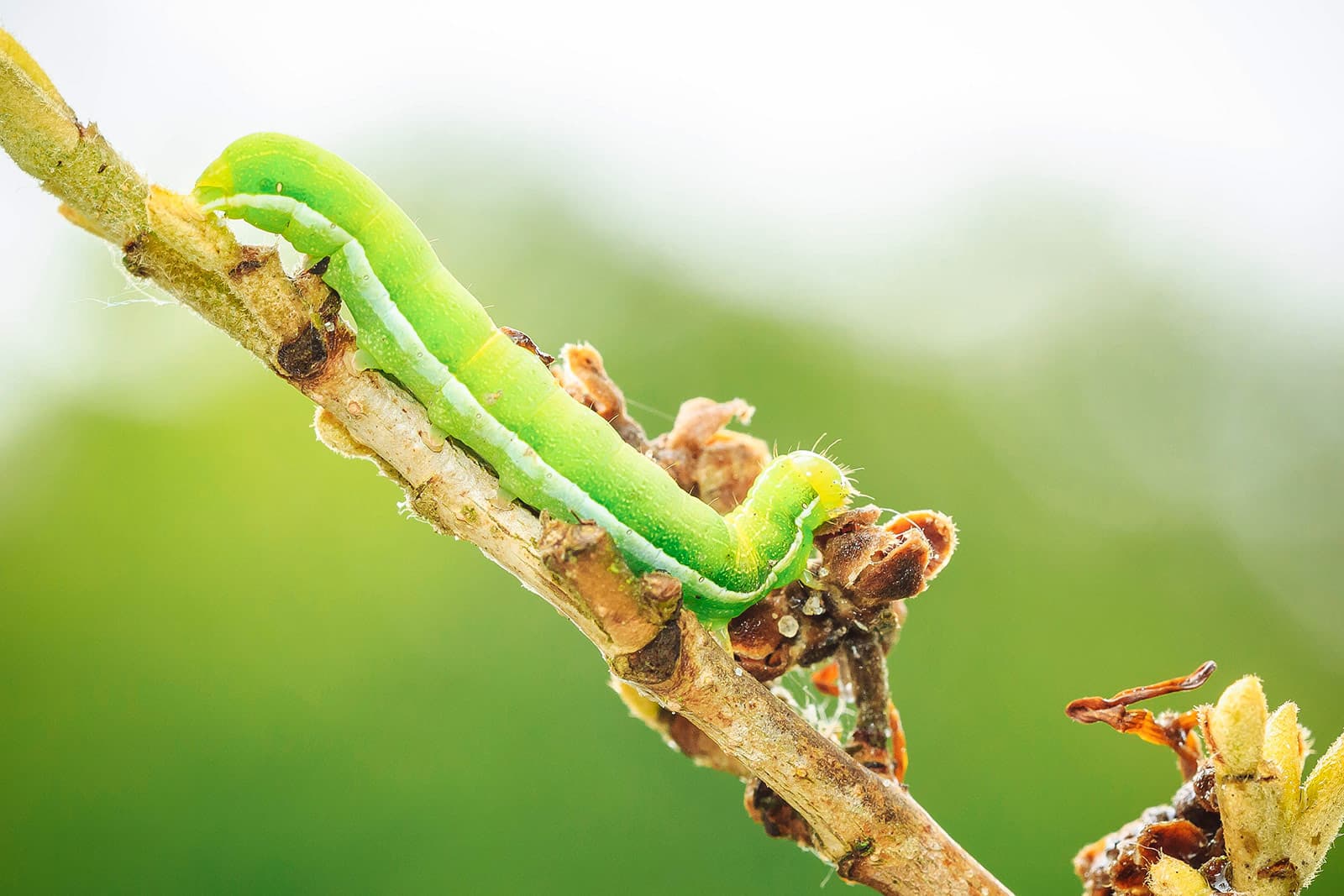
- Scientific name: Phlogophora meticulosa
- Turns into: Angle shades moth
- Found in: Europe, Algeria, Asia Minor, Armenia, and Syria
The angle shades moth caterpillar appears completely lime green at first, but look closer and you’ll find thin yellow lines that run vertically down the body, separating the segments.
However, some angle shades caterpillars have pinkish-brown bodies with the same colored lines, so this one can be a bit tricky to identify if you don’t know the type of host plant.
The larvae of angle shades moths like to feed on common nettles, hops, docks, red valerian, hazel, brambles, birches, and oaks.
Angus’ datana moth caterpillar
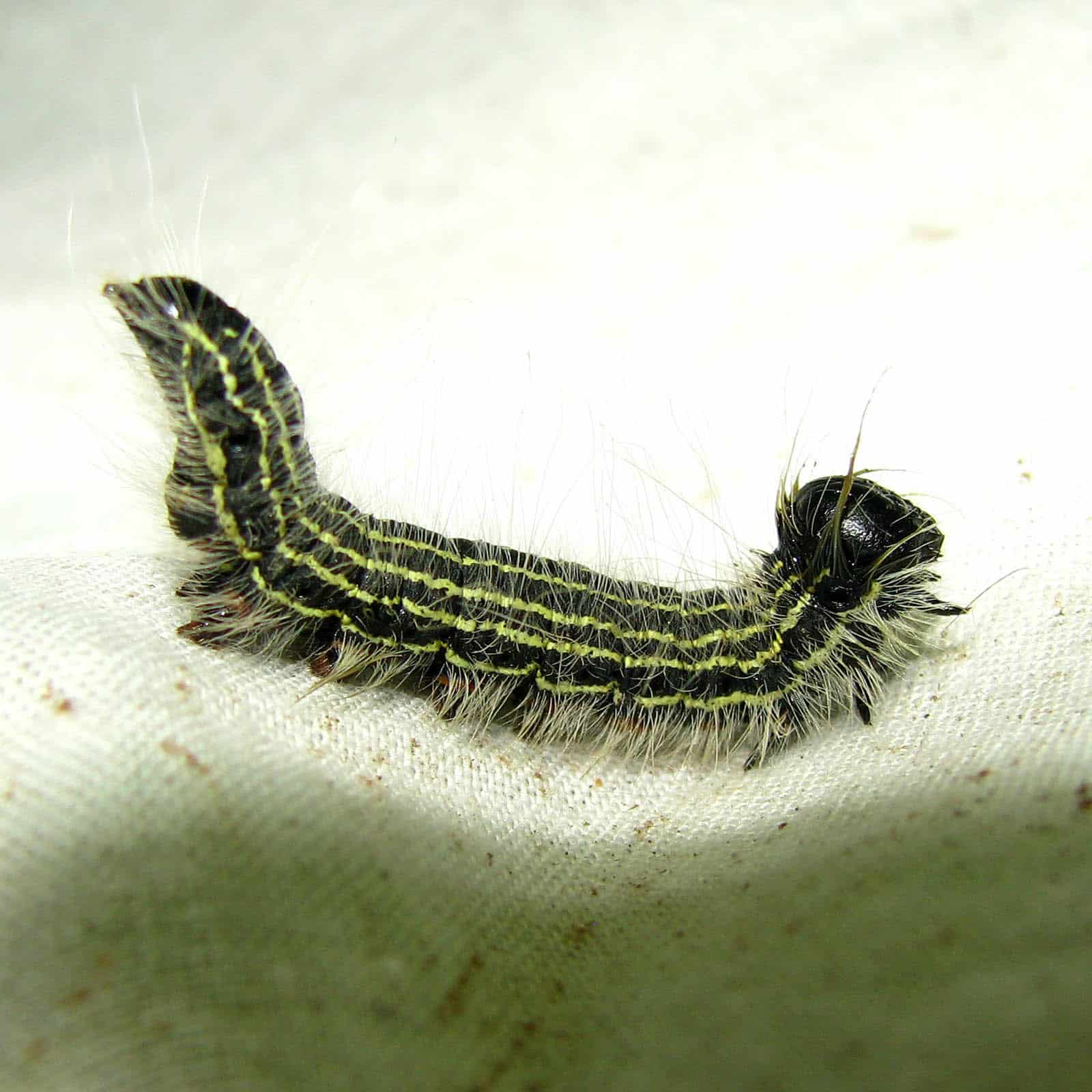
- Scientific Name: Datana angusii
- Turns into: Angus’ datana moth
- Found in: Midwestern, eastern, southeastern, and southern United States
The Angus’ datana moth caterpillar can be recognized by the fine, wispy white “whiskers” all over its body. Though the long hairs may imply this is a stinging caterpillar, there’s no evidence that the caterpillar does in fact sting—though handling it with bare hands should be avoided if possible.
The Angus’ datana moth caterpillar is black with a black head and thin white lines that run the entire length of its body. It can grow up to 2 inches (5 centimeters) long.
Its favorite host plant is walnut trees, though it also feeds on the leaves of apple, oak, birch, and willow trees.
Azalea caterpillar
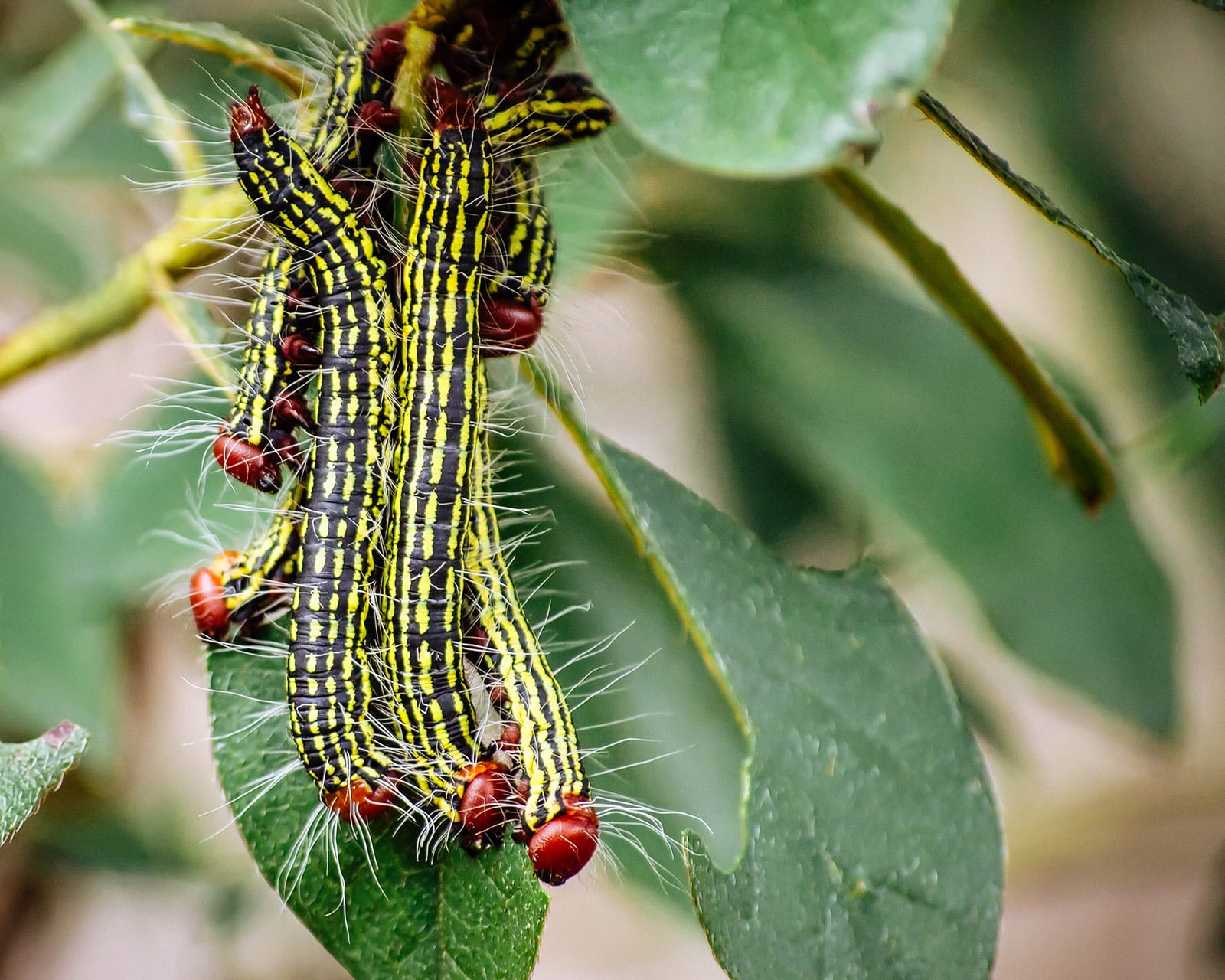
- Scientific Name: Datana major
- Turns into: Azalea moth
- Found in: Maryland to Florida, west to Kansas and Arkansas
Also known as “Labor Day” worms because they’re often discovered around Labor Day, azalea caterpillars go through multiple appearance changes, eventually turning into their most recognizable form: black with yellow stripes, reddish heads, and fat red prolegs.
When disturbed, azalea caterpillars often raise their heads and tails into a C shape.
The primary host plants are—unsurprisingly—azaleas, though the larvae also feed on Andromeda, blueberry, apple, and even oak. They become more destructive as they mature, so it’s important to remove them as soon as they’re found.
Black swallowtail caterpillar
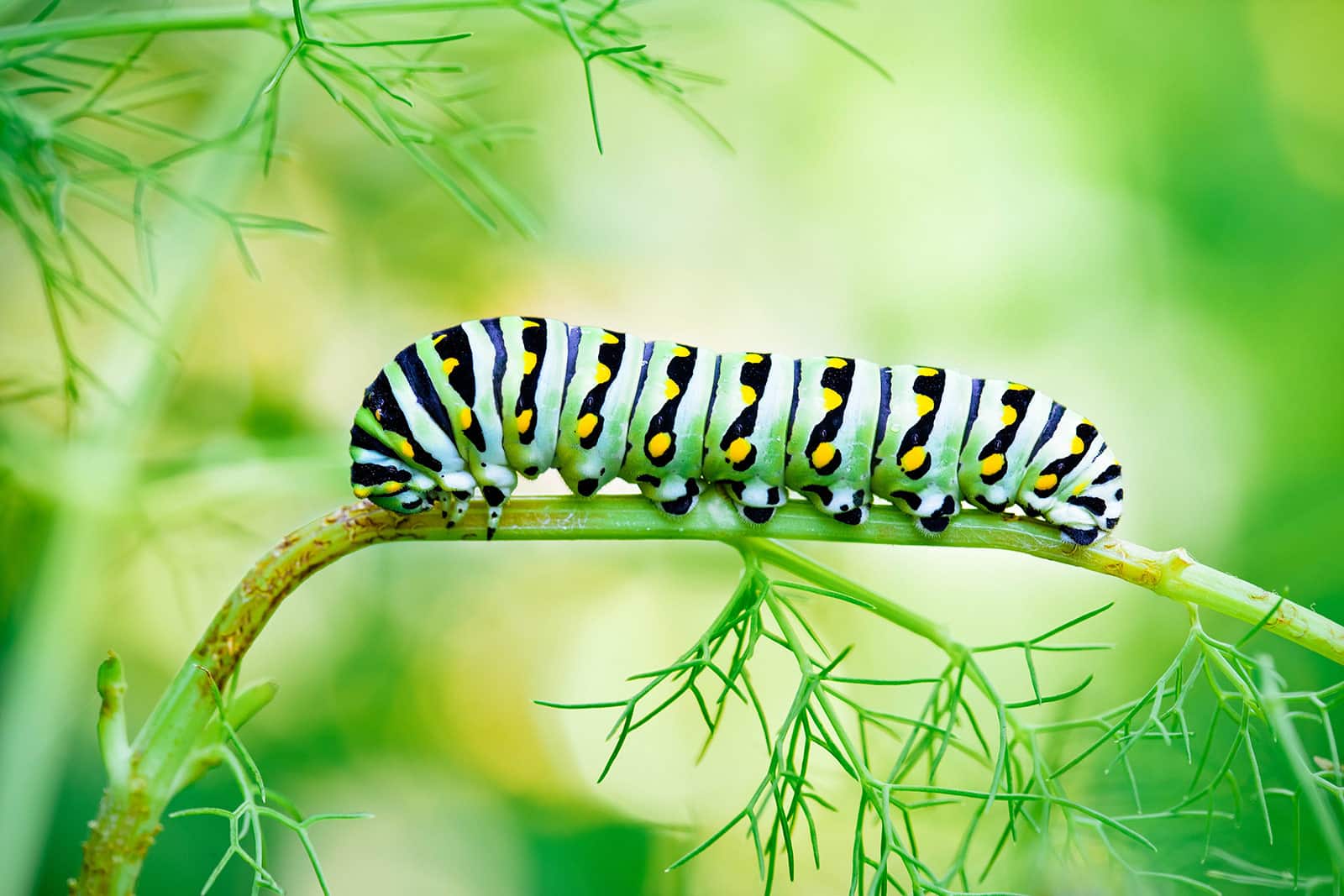
- Scientific name: Papilio polyxenes
- Turns into: Black swallowtail butterfly
- Found in: Southern Canada, most of the eastern and midwestern United States west to the Rocky Mountains, and southwest into Arizona and northern Mexico
The black swallowtail caterpillar is sometimes mistaken for the monarch caterpillar because of its vivid stripes, but that’s where the similarity ends.
Black swallowtail caterpillars have stout green bodies with black and yellow stripes; the stripes can also have yellow dots on top.
All swallowtail caterpillars share a common trait in having an osmeterium, a glandular defense mechanism that resembles a forked tongue sticking out from behind the head. When activated during times of stress, the osmeterium releases a foul odor to deter predators.
If you grow any plants in the parsley family, such as parsley, dill, fennel, and carrots, you’ll often find larvae feeding on the leaves.
Brown hooded owlet caterpillar (calico paint caterpillar)

- Scientific name: Cucullia convexipennis
- Turns into: Brown hooded owlet moth
- Found in: Northeastern United States and adjacent parts of Canada
Though this caterpillar is the larval form of the brown hooded owlet moth, it’s sometimes also called a calico paint caterpillar.
It’s a member of the Noctuidae family and has a similar appearance to the zebra moth caterpillar (which I discuss below), so they’re often mistaken for each other when trying to identify them.
The brown hooded owlet caterpillar has a glossy black head and body; a wide orange stripe centered between black, white, and yellow pinstripes that run down the back; short yellow and white lines on the sides; and a horizontal red line along the bottom by its legs.
The larvae like to feed on asters, goldenrods, and other low-growing plants.
Cinnabar caterpillar

- Scientific name: Tyria jacobaeae
- Turns into: Cinnabar moth
- Found in: North America, Europe, Australia, New Zealand, and western and central Asia to Siberia and China
The graphic black- and orange-striped pattern on the cinnabar caterpillar makes it easy to recognize from afar, as it almost resembles tiger stripes!
Like many other insects that employ a natural defense mechanism, these bold colors serve as a warning to predators: Don’t eat me, I taste terrible and can poison you!
And in the case of cinnabar caterpillars, that’s actually true. The larvae can be found happily munching on their preferred host plant, the bitter and rather unpalatable yellow-flowered ragwort.
While ragwort is known to be toxic and can poison horses and other livestock if ingested, the plant has no ill effect on cinnabar caterpillars. They actually benefit from this toxicity by becoming toxic themselves if they eat enough of it, so predators tend to stay away.
Cross-striped cabbageworm
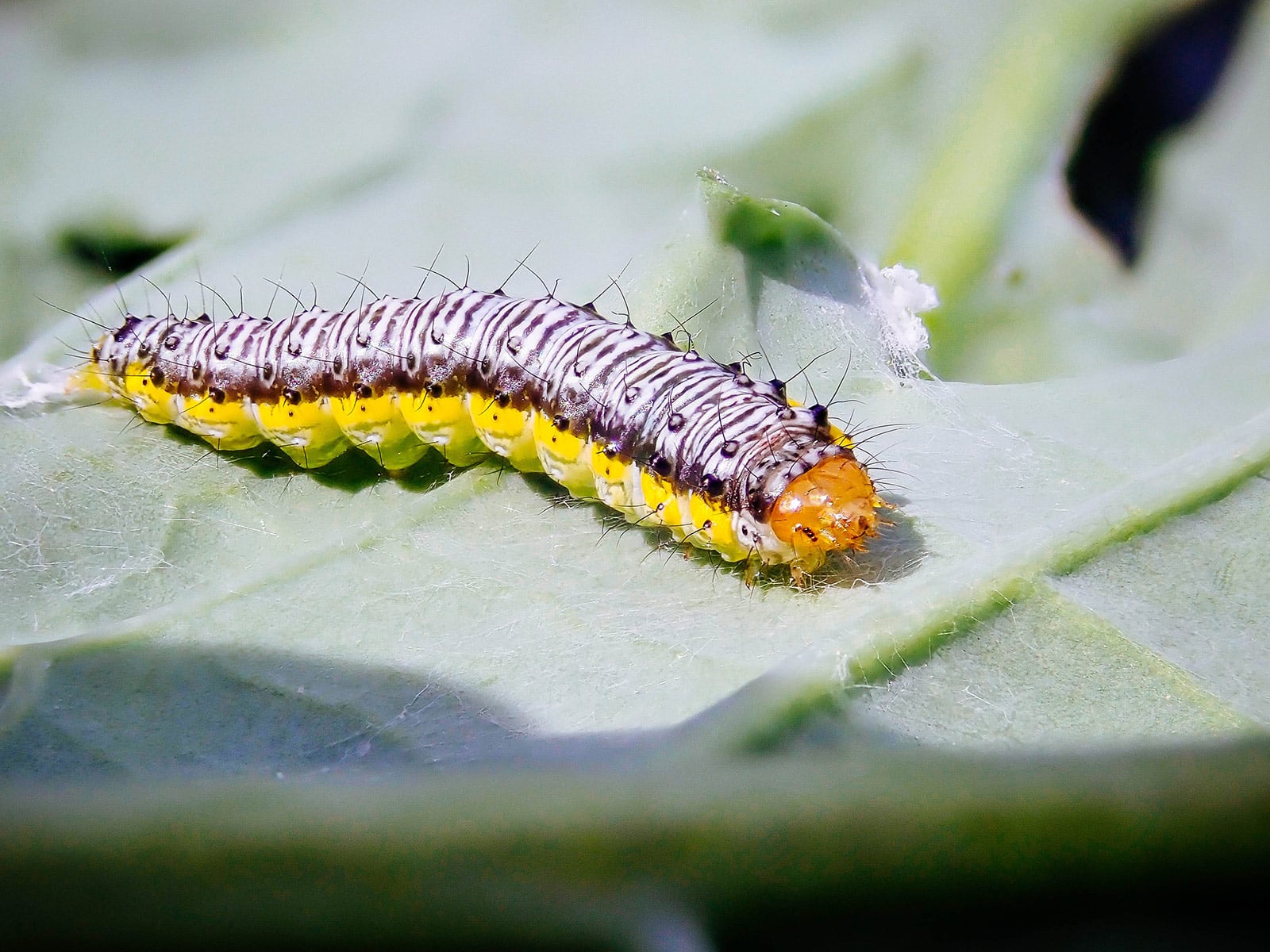
- Scientific name: Evergestis rimosalis
- Turns into: Cross-striped cabbageworm moth
- Found in: Southern New York, West Virginia, Illinois, Colorado, and Washington in the north, and from Florida to Texas and Mexico in the south
The cross-striped cabbageworm may have “worm” in its name but it’s one of the three main caterpillar pests on brassica crops (the other two being cabbage white caterpillars and cabbage looper caterpillars, which you can find in this guide to green caterpillars).
The cross-striped cabbageworm is identified by its small green body (measuring about 1 to 1.5 centimeters, or 0.4 to 0.6 inches long) featuring a yellow stripe that runs horizontally down each side, with a row of black dots above each yellow stripe. Black-and-white pinstripes appear across the back along with thin black spines.
Despite their visible spines, these caterpillars cannot sting or harm you but they are known for destroying cole crops like kale, cabbage, broccoli, cauliflower, collards, and turnips, so make sure you keep them away from your vegetable garden.
Giant sphinx caterpillar

- Scientific name: Pseudosphinx tetrio
- Turns into: Tetrio sphinx moth
- Found in: Southern Brazil through Central America, Mexico, and the West Indies to southern Florida, southern Mississippi, Arkansas, Texas, and southern Arizona
You can’t miss the giant sphinx caterpillar—not only because of its prominent stripes, but also because of its massive size! (Hence its name.)
Growing to be around 6 inches (15 centimeters) long, this caterpillar is easily identified by a velvety black body with thin, evenly spaced, pale yellow stripes that run the entire length of its body.
It has a bright red head with an orange band behind the head, and orange thoracic legs and prolegs with tiny black spots. The tail features a long black horn measuring about 1 inch (2.5 centimeters).
Giant sphinx moth larvae often appear on frangipani trees and other members of the dogbane family.
Gulf fritillary caterpillar

- Scientific name: Agraulis vanillae
- Turns into: Gulf fritillary butterfly (passion butterfly)
- Found in: Southern United States southward through Mexico, Central America and the West Indies to South America
The very cool-looking gulf fritillary caterpillar becomes more and more spiky as it matures. In its last instar (life stage), the caterpillar has a red body adorned with purplish-gray stripes running horizontally from head to rear.
Black branched spines cover its entire body and despite its intimidating appearance, the gulf fritillary caterpillar doesn’t sting. It’s often found in urban gardens, parks, pastures, and other open and sunny areas like roadsides and fields.
The gulf fritillary butterfly is sometimes called the passion butterfly, as its larvae primarily feed on passionflower and passionvine.
Monarch caterpillar
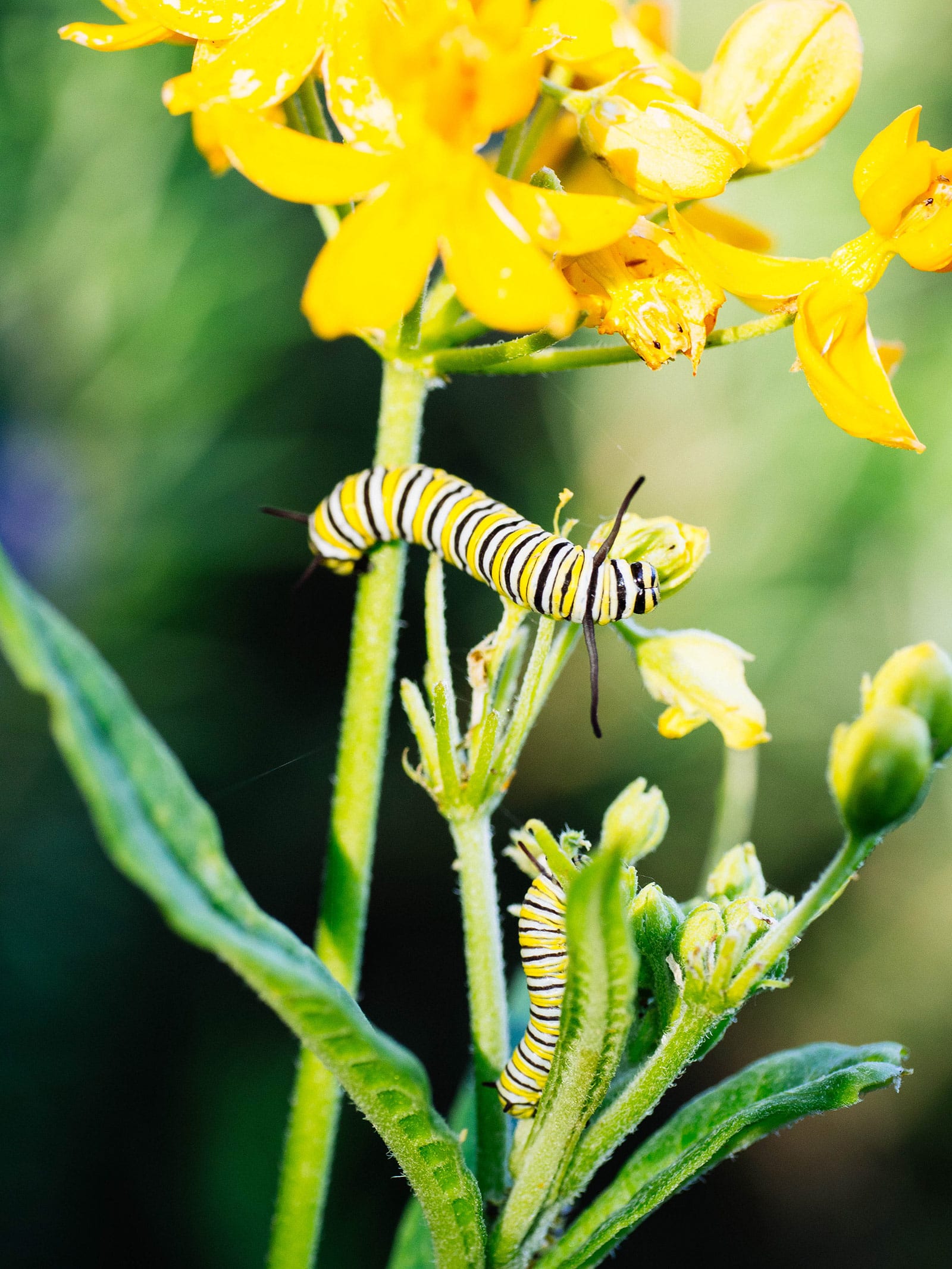
- Scientific name: Danaus plexippus
- Turns into: Monarch butterfly
- Found in: North America
The monarch caterpillar is one of the most commonly found caterpillars on this list and also one of the most recognizable.
Its plumpish body features black, yellow, and white stripes across the segments. The monarch caterpillar also has two pairs of tentacles (horn-like structures that are thought to be sensory organs), one pair at the thorax and one pair on the abdomen.
At maturity, the caterpillar can grow up to 2 inches (5 centimeters) long. The larva feeds exclusively on milkweed plants, which are toxic to many animals. But to the monarch, the toxins have no effect and are simply stored in its body while it’s growing. When it emerges as a butterfly, the monarch’s vivid colors warn potential predators that it’s poisonous.
Orange-striped oakworm (orange-tipped oakworm)
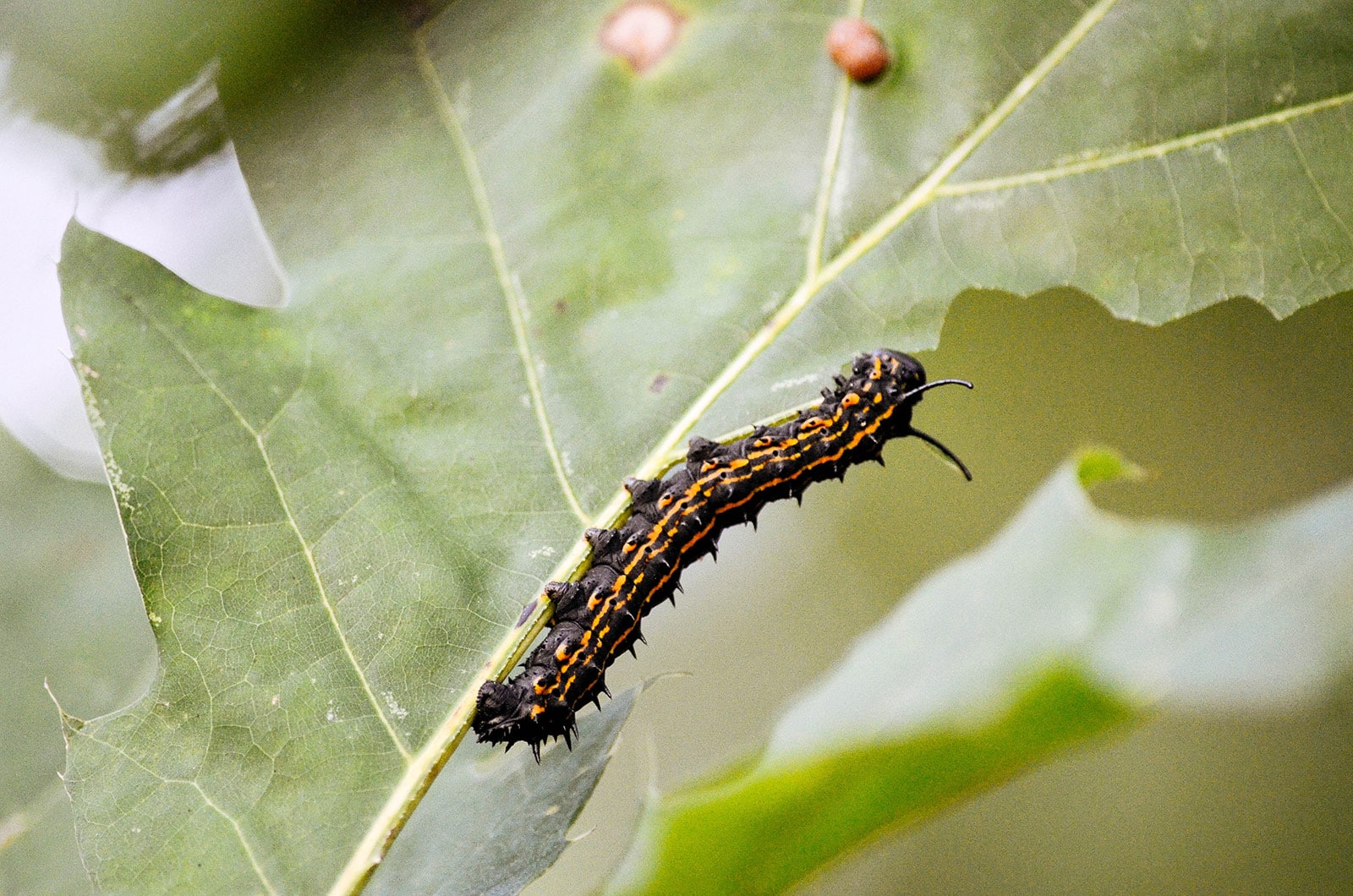
- Scientific name: Anisota senatoria
- Turns into: Orange-striped oakworm moth (orange-tipped oakworm moth)
- Found in: Southern Maine west across the Great Lakes region to central Minnesota, and south to central Georgia, central Alabama, central Mississippi, Louisiana, and east Texas
The orange-striped oakworm (also called the orange-tipped oakworm) is a caterpillar that takes up refuge in various types of oak trees, and as such, you’ll often find them in your yard after noticing that your trees have been defoliated.
These caterpillars can easily be recognized by the multiple thin, yellow-orange stripes that run longitudinally down their black bodies. They have two black “horns” on their heads and smaller black spines on their segments. Orange-striped oakworms can grow to be around 2.5 inches (5 centimeters) long.
Besides oaks, the larvae also feed on the leaves of birch, hickory, and maple trees.
Queen caterpillar
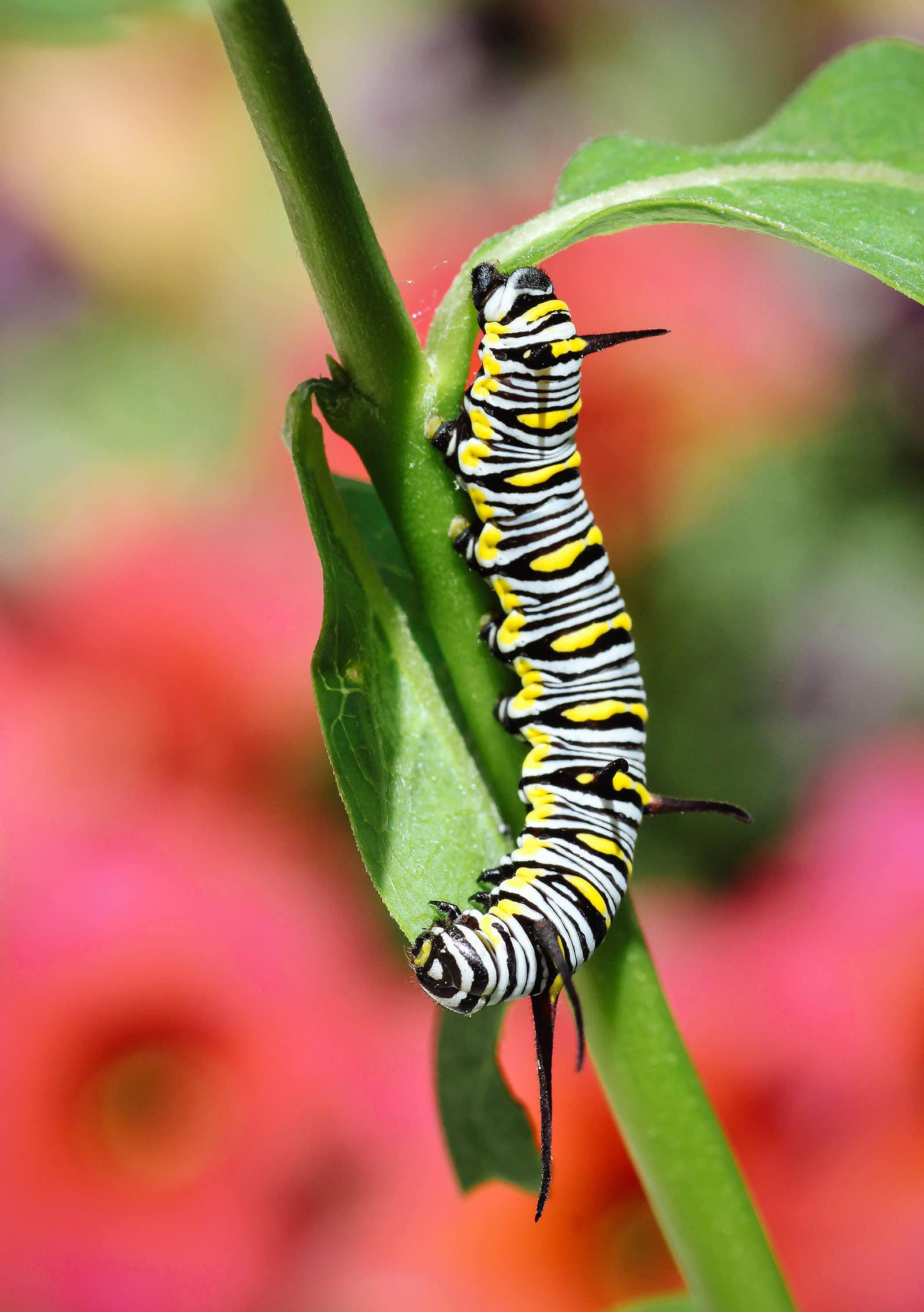
- Scientific name: Danaus gilippus
- Turns into: Queen butterfly
- Found in: North America
The queen caterpillar is sometimes misidentified as a monarch caterpillar, and though the two species are related (and have similar-sounding noble names), they have distinct visual differences.
While the queen caterpillar also has black, yellow, and white stripes, the patterning is less uniform than the stripes on a monarch. Queen caterpillars have thicker black bands with dabs of yellow and thinner black lines overlaying the white sections.
Whereas monarch caterpillars have two pairs of tentacles, queen caterpillars have three pairs: two longer tentacles toward the front, and a shorter pair near the rear.
The larvae primarily feed on milkweeds and dogbanes, and can sometimes be found among monarch larvae on the same plants. Queen larvae also retain the toxicity of milkweed in their bodies, which help protect them against predators.
Rosy maple caterpillar (green-striped mapleworm)
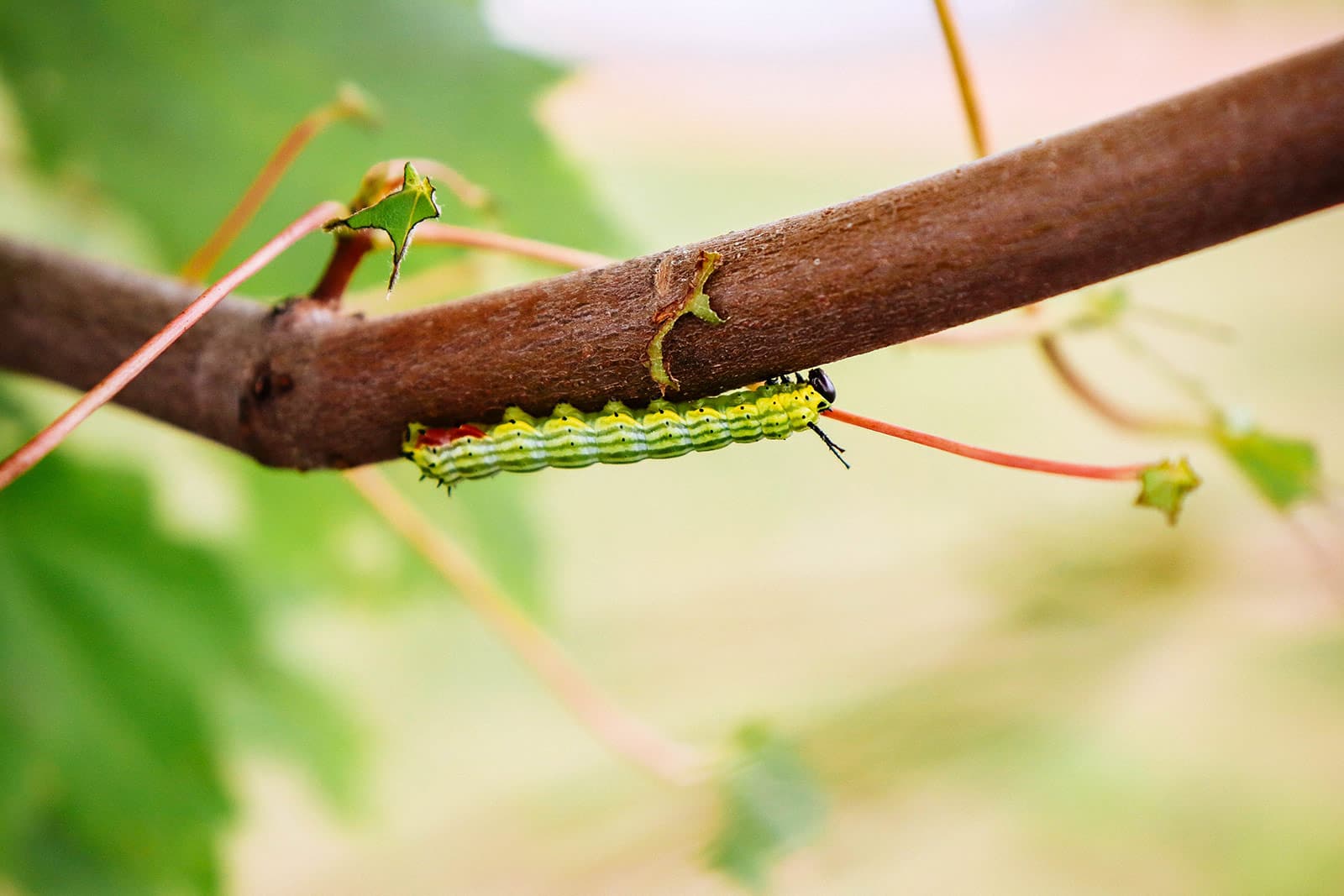
- Scientific name: Dryocampa rubicunda
- Turns into: Rosy maple moth
- Found in: Eastern United States to southeastern Canada
The rosy maple caterpillar (also called the green-striped mapleworm) has a bright green body overlaid with white stripes that extend from head to rear. The segments also feature lots of little black dots that run lengthwise down the sides of the body, while the head is reddish-orange and the tail has a streak of red.
Two small black spines are can be seen on top of the head, and as the caterpillar matures, black spines emerge from the black dots.
Rosy maple caterpillars can grow up to 2 inches (5 centimeters) long and feed mostly on maple trees, with some larvae occasionally found on oaks.
Striped garden caterpillar

- Scientific name: Trichordestra llegitima
- Turns into: Striped garden caterpillar moth
- Found in: Eastern North America from Newfoundland to Florida, west to Texas, and north to Saskatchewan
The striped garden caterpillar has a somewhat generic common name, but it specifically refers to the larvae of Trichordestra llegitima, a moth of the Noctuidae family.
These caterpillars have tan faces and slender brown bodies with a pair of longitudinal yellow stripes edged in black.
Host plants for garden striped caterpillars include a wide range of woody and herbaceous plants, including asparagus, aster, bean, broomrape, cherry, clover, dogbane, goldenrod, milkweed, mustard, pea, pokeweed, raspberry, tobacco, violet, willow, and yarrow, though the larvae prefer to feed on grasses.
White-lined sphinx moth caterpillar
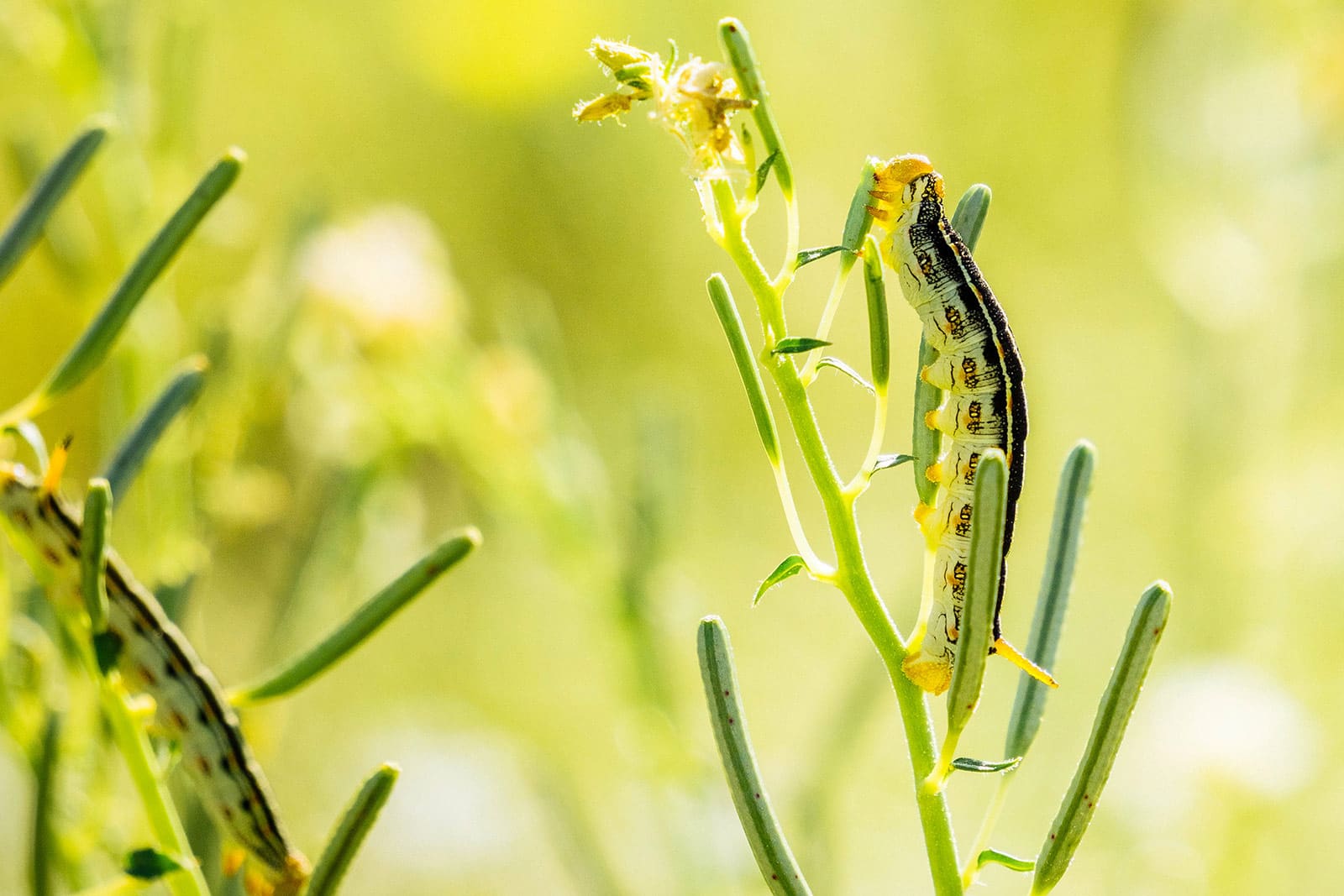
- Scientific name: Hyles lineata
- Turns into: White-lined sphinx moth
- Found in: Central America through Mexico and the West Indies to most of the United States and southern Canada
The white-lined sphinx moth caterpillar is a type of hornworm with a characteristic yellow or orange “horn” at the rear. The horn sometimes has a black tip and while it looks like a stinger, it actually poses no threat.
This caterpillar’s plump body ranges from light to dark green, with a series of black lengthwise stripes and yellow and orange spots down the sides. It can grow relatively large, up to 3.5 inches (9 centimeters) in length.
Host plants for white-lined sphinx moth larvae include willow weed, evening primrose, fuchsia, four o’clocks, purslane, tomatoes, and grapes.
Zebra caterpillar
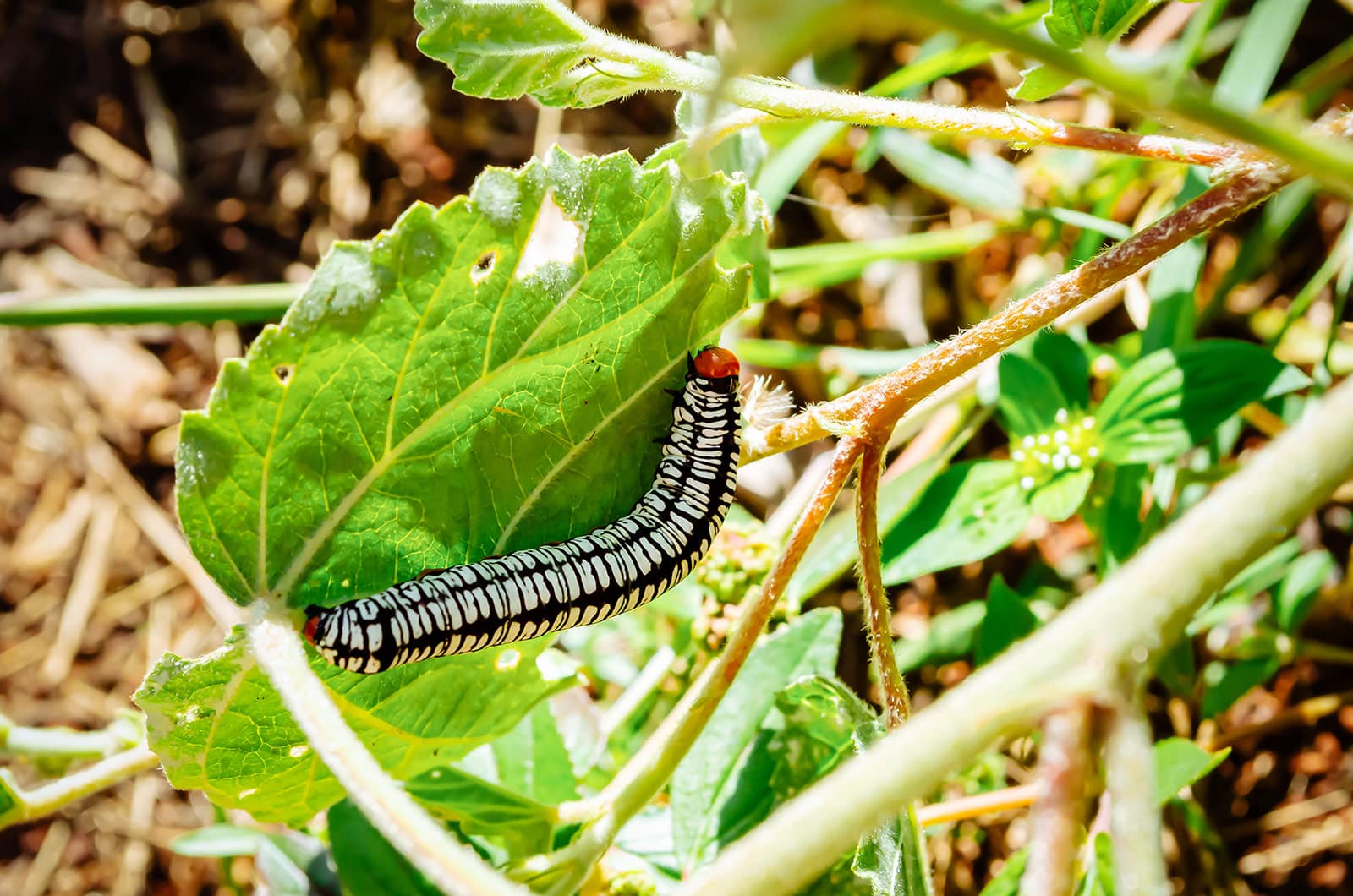
- Scientific name: Melanchra picta
- Turns into: Zebra caterpillar moth (Zebra Arches)
- Found in: Southern half of Canada and northern half of United States
The zebra caterpillar is the larval form of Melanchra picta, or zebra caterpillar moth, a type of owlet moth that’s named for its caterpillar.
You can probably guess by its name that this caterpillar can be identified by its zebra-like black-and-white pattern along its body. At maturity, the caterpillar also sports a thick black stripe running down the length of its back, along with a thin yellow stripe on each side of the black stripe. Zebra caterpillars have reddish-brown heads and can grow up to 1.6 inches (4 centimeters) long.
Their diet consists mainly of cultivated crops like carrots, cabbage, beets, strawberries, blueberries, blackberries, apples, plums, and cherries, so they’re a common caterpillar in gardens and can also be found in fields where clovers, dandelions, dock, pigweed, and alfalfa grow.


